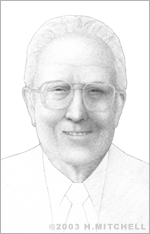Reynold Johnson
Reynold Johnson was born in 1906 in Minnesota. He attended the University of Minnesota, achieving his BS in education administration in 1929. He then began teaching science and math at a local high school.
His life changed in 1933 when he lost his teaching job and began developing an idea he had for an electromechanical device for automatically marking and grading pencil-marked multiple choice tests. One of the companies he attempted to interest was IBM, which initially refused the design. But in 1934, the company reassessed the machine and saw Johnson's great potential. They offered him a position as an engineer at their Columbia University and Endicott laboratories in New York.
Johnson became one of the company’s most prolific inventors, specializing in electromechanical devices. The company became aware of a growing need for improved data storage systems in the early 1950s and asked Johnson to lead a research team in Silicon Valley to work on this project. In 1952, he assembled the team, which began examining magnetic disk storage systems. IBM asked the team to use their research to develop a mass random access memory (RAM) storage system within two years that was to be of commercial quality. RAM gives a user the ability to seek and access a particular record or data file in storage rather quickly – within seconds or even fractions of seconds. At the time, data was stored in card files or magnetic tape files, and it sometimes took several minutes to find what one was looking for.
Johnson and his team paid close attention to a report about magnetic disk storage experiments conducted by Jacob Rabinow of the National Bureau of Standards. They decided that Rabinow’s disk concept had beneficial characteristics and concluded that their design would be based on a disk drive configuration. In contrast to the cylinder configuration that was more widely used at the time, Johnson believed that a disk system would allow for greater potential for future miniaturization, cost-effectiveness, and system reliability.
In late 1955, Johnson and his team presented the first-ever functioning hard drive to IBM management. The RAMAC (Random Access Method of Accounting Control) was very large, weighing in at one ton, but it met IBM’s original specifications, with access time to any given file averaging about one second. It used fifty 24-inch magnetic disks rotating at 1200 RPM on one shaft with two read/write heads that could quickly access the files. In 1956, IBM introduced the first commercial magnetic disk drive, the RAMAC 350, and even today, all disk drives are based on Johnson’s basic system.
Johnson obtained 90 patents over the course of his career, many in the field of card handling, punching, and reading devices. He also worked with Sony to invent the process of storing video on video tape that was half the width of normal video tape, leading to the creation of the VCR. He was honored with numerous awards, including the National Medal of Science from President Reagan in 1986, and in 1992, the IEEE established the annual Reynold B. Johnson Award for the Advancement of Information Storage Technology.
Johnson retired in 1971 and continued to work at his Education Engineering Associates consulting company, where he created a microphonograph, used in Fisher-Price’s “Talk to Me” books. He died in 1998 at the age of 92.


